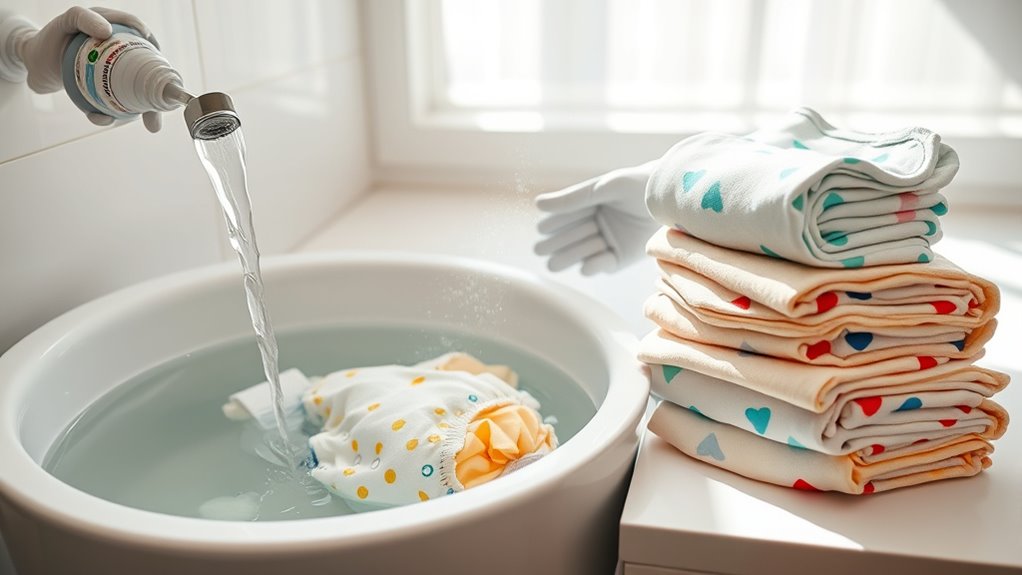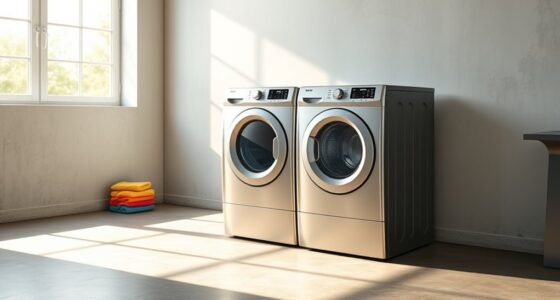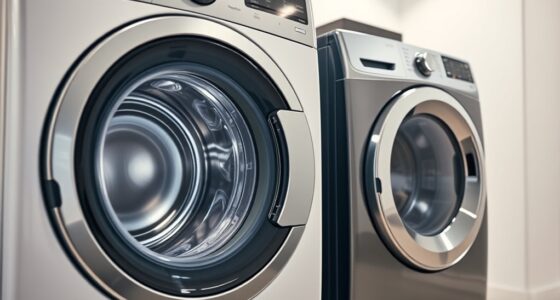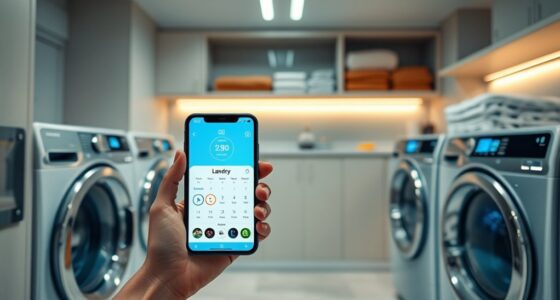To safely sanitize cloth diapers and baby laundry, rinse off solids first, then wash in hot water (around 60°C/140°F) with eco-friendly, fragrance-free detergent. Avoid harsh chemicals, fabric softeners, and bleach. Air dry diapers in sunlight to naturally disinfect and remove odors, or use a low-heat dryer if needed. Regularly check for wear and tear to keep your baby’s skin safe. Keep exploring for more tips on maintaining a healthy, eco-friendly routine.
Key Takeaways
- Rinse cloth diapers with cold water to remove solids before washing.
- Wash on a hot cycle (~60°C/140°F) using eco-friendly, fragrance-free detergent for effective sanitization.
- Add natural disinfectants like vinegar or baking soda to enhance cleaning and odor control.
- Air dry in sunlight or use a low-heat dryer to naturally disinfect and prevent bacteria buildup.
- Regularly inspect diapers for damage and maintain proper cleaning routines for ongoing hygiene.
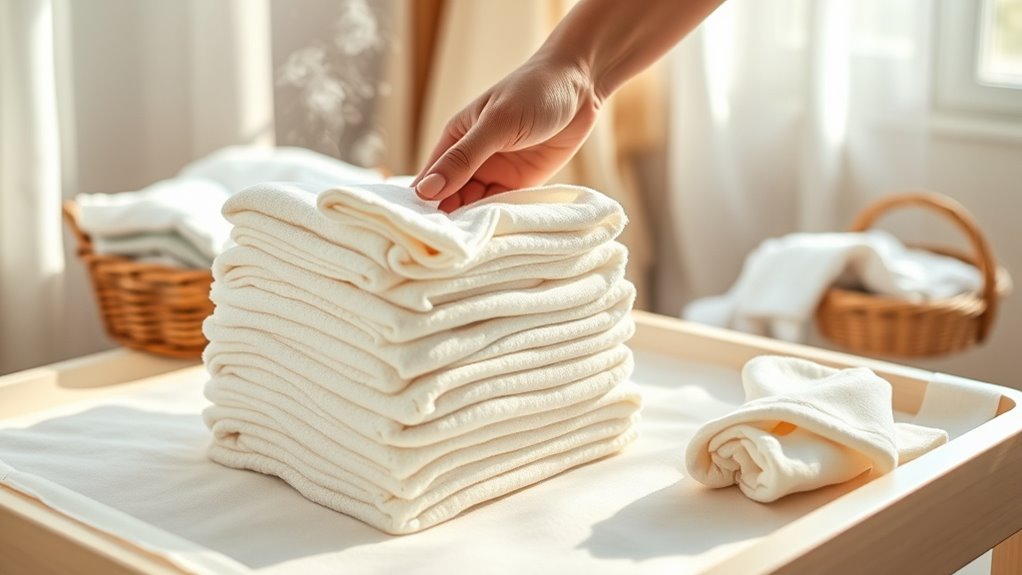
Keeping cloth diapers clean is vital for your baby’s health and comfort. When you prioritize proper washing and sanitizing, you help prevent diaper rash, keep your little one comfortable, and guarantee their skin stays healthy. Diaper rash prevention starts with removing all traces of waste, bacteria, and lingering odors. It’s important to develop a routine that thoroughly cleans your cloth diapers after each use. Regular washing with eco friendly washing methods not only protects your baby but also minimizes your environmental impact. Using eco friendly washing methods involves choosing biodegradable detergents, avoiding harsh chemicals, and limiting the use of fabric softeners or bleach, which can irritate sensitive skin and damage the fabric over time. These gentle cleaning techniques ensure your diapers stay fresh and safe for your baby’s delicate skin.
To effectively sanitize your cloth diapers, start by rinsing off any solids thoroughly, either with cold water or by using a pre-wash cycle. This step prevents waste from sticking to the fabric and reduces staining. Next, wash the diapers on a hot water cycle—most manufacturers recommend water temperatures around 60°C (140°F)—to kill bacteria and germs while maintaining the fabric’s integrity. Be sure to select an eco friendly detergent that’s free from dyes and synthetic fragrances, which can cause irritation. Many brands now make plant-based or biodegradable options that are gentle yet effective. Avoid overloading your washing machine; giving your diapers enough space allows the water and detergent to reach all surfaces, ensuring a deep clean.
Once washed, you have the option of using a natural disinfectant like a vinegar rinse or adding a small amount of baking soda to the wash cycle, both of which can enhance sanitizing without compromising eco friendliness. After washing, it’s vital to dry the diapers thoroughly—preferably in the sun, which naturally disinfects and helps eliminate odors, or in a well-ventilated dryer on a low heat setting. Proper drying ensures no dampness remains that could foster bacteria growth or cause mildew. Regularly inspecting your diapers for signs of wear and tear helps maintain their effectiveness and prevents leaks or rash-causing irritations.
Frequently Asked Questions
Can I Use Vinegar to Sanitize Cloth Diapers?
You can use vinegar to sanitize cloth diapers, but you should do so with caution. Vinegar safety as a natural sanitizer is debated because it may not eliminate all bacteria effectively. If you choose this method, dilute vinegar properly and avoid using it too frequently, as it can damage fabrics over time. Relying on natural sanitizers like vinegar works best for routine freshness, but for thorough sanitization, consider hot water or specialized diaper sanitizers.
How Often Should I Sanitize Cloth Diapers?
You should sanitize your cloth diapers at least once a week to keep bacteria at bay, but more often if your baby develops diaper rash. Remember, a clean diaper is a healthy diaper, so use your washing machine’s hot settings for thorough disinfecting. Regular sanitizing helps prevent diaper rash and keeps your baby comfortable. When in doubt, don’t hesitate to do an extra wash—better safe than sorry.
Are There Natural Sanitizing Methods for Baby Laundry?
Yes, you can use natural disinfectants for baby laundry to promote laundry safety. Options like adding white vinegar or tea tree oil to your wash can help naturally disinfect without harsh chemicals. Vinegar neutralizes bacteria and odors, while tea tree oil offers antimicrobial properties. Just make certain you follow proper laundry practices, use the right amounts, and avoid any substances that might irritate your baby’s skin. This way, you keep laundry safe and clean naturally.
Is It Safe to Use Bleach on Cloth Diapers?
Yes, using bleach on cloth diapers can be safe if you follow proper bleach safety guidelines. Always dilute the bleach properly and use it sparingly to prevent damage to the diaper fabric. Avoid overuse, as excessive bleach can weaken the fabric and cause irritation. Make sure to rinse thoroughly, and opt for oxygen-based alternative sanitizers if you’re concerned about harsh chemicals. Proper use guarantees your diapers stay clean and safe for your baby.
Do Sanitize Routines Affect Diaper Fabric Longevity?
Sanitize routines can impact diaper fabric durability if you overdo them or use harsh chemicals too frequently. Frequent laundering, especially with strong disinfectants, may weaken the fabric over time, reducing its lifespan. To protect your diapers, balance your laundering frequency with gentle sanitizing methods, like hot water washes or natural disinfectants. This approach helps maintain diaper fabric durability while keeping your baby’s laundry safe and clean.
Conclusion
By sanitizing your cloth diapers and baby laundry diligently, you’re nurturing a fortress of cleanliness around your little one. Think of your efforts as a gentle gardener tending to delicate blooms, ensuring they thrive free from harm. With each wash and sanitize, you weave a shield of purity, transforming routine chores into acts of love. In this dance of care, your baby’s comfort becomes a radiant star guiding your every move toward a healthier, happier start.
